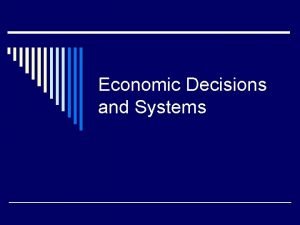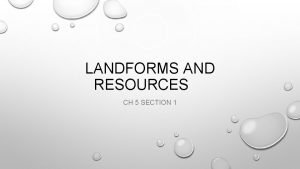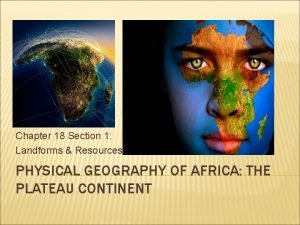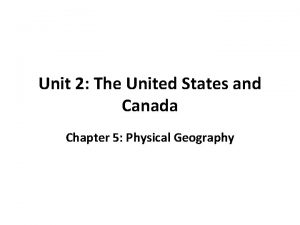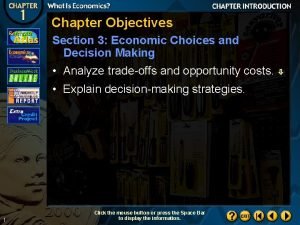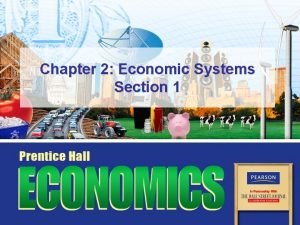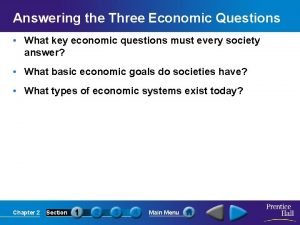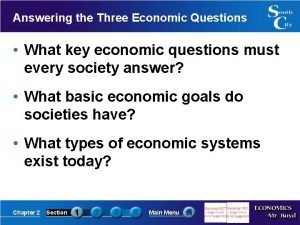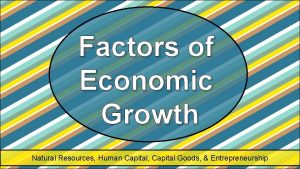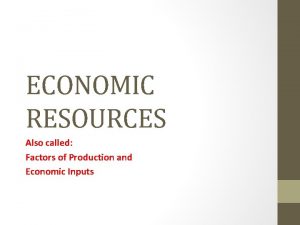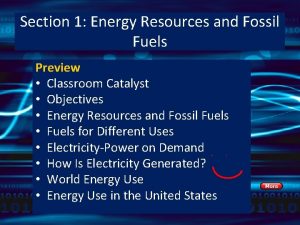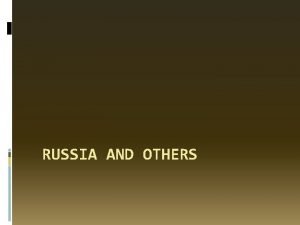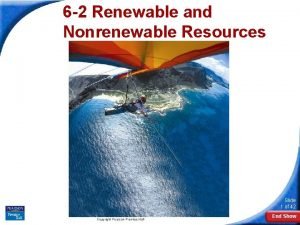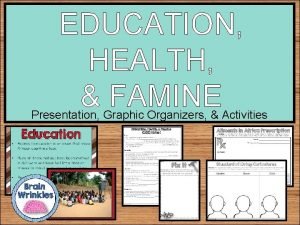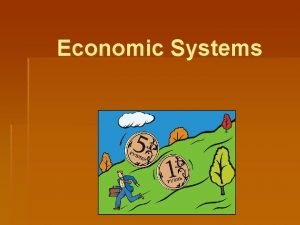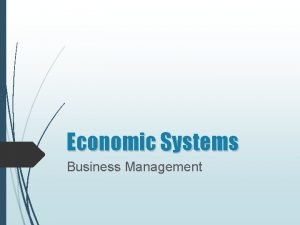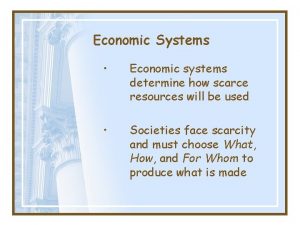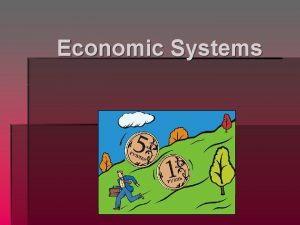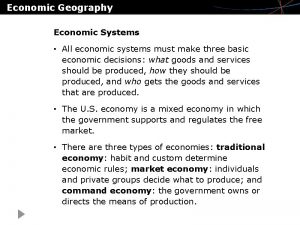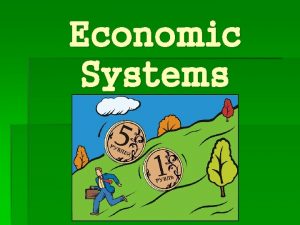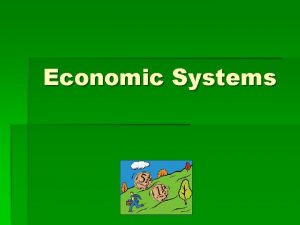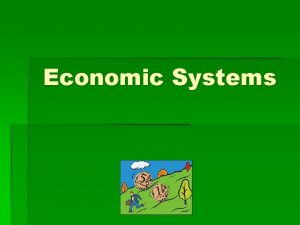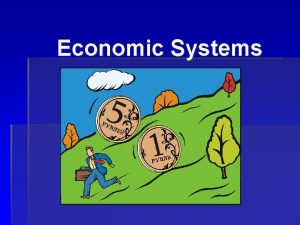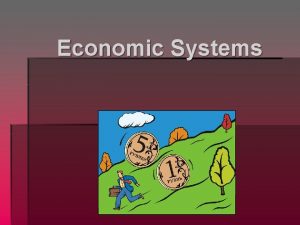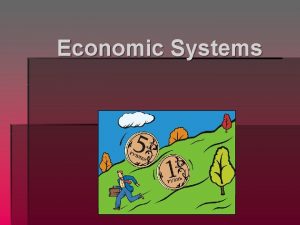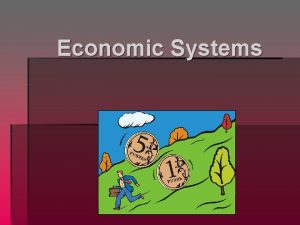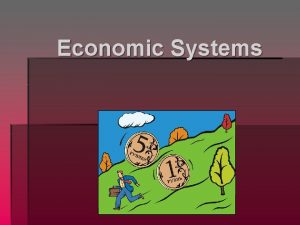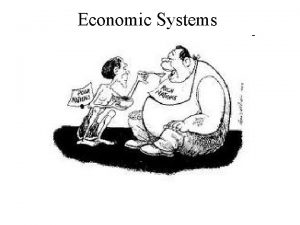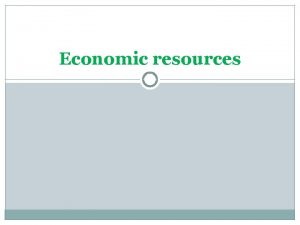Chapter 2 Economic Resources and Systems Section 2

































- Slides: 33

Chapter 2 Economic Resources and Systems Section 2. 1 Economic Resources

Read to Learn Explain how scarcity requires individuals and nations to make decisions about resources. Describe the four factors of production.

The Main Idea Both people and countries must deal with the problem of scarcity. Nations do not have enough factors of production to produce everything that their population wants. Factors of production are all the economic resources necessary to produce a society’s goods and services.

Key Concepts Making Economic Decisions Factors of Production

Key Terms scarcity the lack of resources factors of production all the economic resources necessary to produce a society’s good and services

Key Terms natural resources raw materials from nature that are used to produce goods labor resources people who make the goods and services for which they are paid

Key Terms capital resources things used to produce good and services resources used by the people entrepreneurial who recognize a business resources opportunity and start a business

Key Terms entrepreneurship The process of recognizing a business opportunity, testing it in the market, and gathering the resources necessary to start and run a business

Key Terms entrepreneur An individual who undertakes the creation, organization, and ownership of a business

Making Economic Decisions The principle of scarcity states that there are limited resources for satisfying unlimited wants and needs. scarcity a lack of resources

Making Economic Decisions Societies and individuals have to deal with a shortage of resources. In this case resources are the items that go into the making of goods and services. This lack of resources is called scarcity. The principle of scarcity states that there are limited resources for satisfying unlimited wants and needs. Because resources are in limited supply, to have one more thing may mean giving up something else. For example, a restaurant owner may forgo plans for a costly new décor to have money to put into kitchen equipment. A city government might decide to cut expenses for most services to be able to hire more police officers. When dealing with scarcity, it is important to think of the best way to use the item that is in short supply.

Factors of Production Factors of production are all the economic resources necessary to produce a society’s goods and services, such as the wheat that grows in the ground, the tractor that harvests its, the labor that turns it into flour, and the distribution system that delivers it to the marketplace. There are four factors of production: natural resources, labor resources, capital resources and entrepreneurial resources.

Natural Resources are raw materials from nature that are used to produce goods. Trees, water, and grains are natural resources. Natural resources can even be processed in various ways to create goods. Even synthetic or artificially produced materials are made by combining or changing natural resources. For example, nylon is a synthetic material derived from coal, water and air. The economy of many countries is primarily based on its natural resources. For example, some Latin American countries rely on their coffee and banana crops. Other countries such as Japan have little land scarce resources and must get them from somewhere else.

Natural Resources Some natural resources such as wheat and cattle are renewable. They can be reproduced. You can breed cattle to make more cattle. Other resources are limited, or nonrenewable. Coal, iron and oil are nonrenewable. The amount of natural resources available to a society has a direct effect on its economy.

Labor Resources Every type of business needs labor resources to produce goods and provide services. Labor resources are people who make the goods and services for which they are paid. Labor can be skilled or unskilled, physical or intellectual. Teachers, coal miners, bank managers, and farm workers are all human resources. Whether you are a cashier or a news anchor, you are a labor resource.

Capital Resources Capital resources make up another factor of production. Capital resources are not the same as capital, or money. Capital resources are things used to produce goods and services, such as buildings, materials and equipment. They are also called capital goods. They include delivery trucks, supermarkets, cash registers and medical supplies. A tractor that a farmer uses to harvest wheat is a capital resource. The headquarters of a major firm is a capital resource. If you are a writer or an accountant, the computer you use is a capital resource.

Entrepreneurial Resources Capital resources make up another factor of production. Capital resources are not the same as capital, or money. Capital resources are things used to produce goods and services, such as buildings, materials and equipment. They are also called capital goods. They include delivery trucks, supermarkets, cash registers and medical supplies. A tractor that a farmer uses to harvest wheat is a capital resource. The headquarters of a major firm is a capital resource. If you are a writer or an accountant, the computer you use is a capital resource.

Graphic Organizer Demand Supply When dealing with scarcity, it is important to think of the best way to use the item that is in short supply.

Graphic Organizer Natural Resources Labor Resources Capital Resources Entrepreneurial Resources

Natural Resources Natural resources can be processed in various ways to create goods. natural resources raw materials from nature that are used to produce goods

Graphic Organizer Renewable resources can be reproduced Wheat Cattle Nonrenewable resources are limited Coal Iron Oil

Being Resourceful During the world oil crisis in 1973, Japan was able to reduce its dependence on oil and enhance productivity through conservation and alternate sources of industrial energy.

Labor Resources Labor resources can be skilled or unskilled, physical or intellectual. labor resources people who make the goods and services for which they are paid

Capital Resources Capital resources are also called capital goods. capital resources the things used to produce goods and services, such as buildings, materials, and equipment

Capital Resources Examples of capital resources include: Delivery trucks Supermarkets Cash registers Farm equipment

Entrepreneurial Resources Entrepreneurial resources meet society’s changing wants and needs. entrepreneurial resources used by the people who recognize opportunities and start businesses

Entrepreneurial Resources Entrepreneurship is necessary when starting a business. entrepreneurship the process of recognizing a business opportunity, testing it in the market, and gathering the resources necessary to start and run a business

Entrepreneurial Resources An entrepreneur accepts the risks and responsibilities of business ownership. entrepreneur an individual who undertakes the creation, organization, and ownership of a business

Entrepreneurial Resources Entrepreneurial resources are individuals who start and direct businesses to produce goods and services to satisfy needs or wants. Labor resources are people who produce the goods or services.

1. Why do all nations face the problem of scarcity? No nation has enough resources to satisfy all of its wants and needs.

2. Identify one similarity and one difference between labor and entrepreneurial resources. Entrepreneurial resources initiate businesses to make new goods and services; labor resources produce goods and services.

3. List five different natural resources. Answers will vary. Examples include water, oil, iron ore.

End of Chapter 2 Economic Resources and Systems Section 2. 1 Economic Resources
 Chapter 2: economic systems worksheet answer key
Chapter 2: economic systems worksheet answer key Economics unit 1 lesson 2 difficult choices
Economics unit 1 lesson 2 difficult choices Chapter 2 economic systems and decision making answer key
Chapter 2 economic systems and decision making answer key Chapter 2 economic systems and decision making
Chapter 2 economic systems and decision making Chapter 2 economic systems and decision making
Chapter 2 economic systems and decision making Chapter 1 economic decisions and systems answer key
Chapter 1 economic decisions and systems answer key Chapter 24 section 1 landforms and resources
Chapter 24 section 1 landforms and resources Landforms of southwest asia
Landforms of southwest asia Landforms and resources
Landforms and resources Chapter 27 section 1 landforms and resources
Chapter 27 section 1 landforms and resources Chapter 18 section 1 landforms and resources
Chapter 18 section 1 landforms and resources Chapter 5 section 1 landforms and resources
Chapter 5 section 1 landforms and resources Chapter 1 section 3 economic choices and decision making
Chapter 1 section 3 economic choices and decision making Transformation processes
Transformation processes Fixed resources definition
Fixed resources definition What is economic growth and development
What is economic growth and development Chapter 2 economic systems answer key
Chapter 2 economic systems answer key Chapter 11 section 1 water resources answer key
Chapter 11 section 1 water resources answer key Chapter 2 section 1 answering the three economic questions
Chapter 2 section 1 answering the three economic questions Chapter 2 section 1 answering the three economic questions
Chapter 2 section 1 answering the three economic questions Renewable resources vs nonrenewable resources
Renewable resources vs nonrenewable resources Economic resources
Economic resources Economic resources are also called:
Economic resources are also called: Economic growth vs economic development
Economic growth vs economic development Topic 2 free enterprise and other economic systems
Topic 2 free enterprise and other economic systems Fossil fuel deposit
Fossil fuel deposit Major landforms in russia
Major landforms in russia 6-2 renewable and nonrenewable resources
6-2 renewable and nonrenewable resources Chapter 36 section 2 human development before birth
Chapter 36 section 2 human development before birth Section quick check chapter 10 section 1 meiosis answer key
Section quick check chapter 10 section 1 meiosis answer key Education health and famine cloze notes
Education health and famine cloze notes What is the purpose of an economic system
What is the purpose of an economic system Pure command system
Pure command system How many economic systems are there
How many economic systems are there





